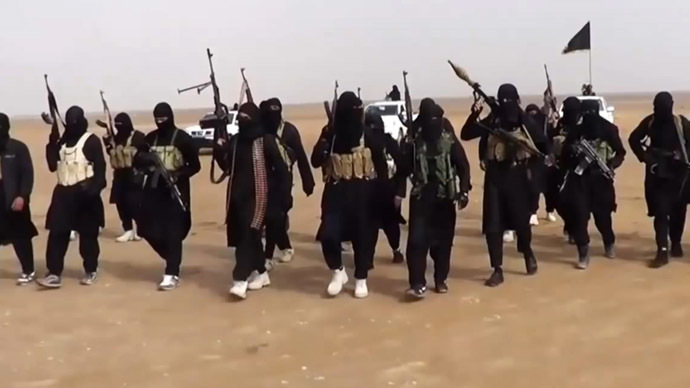US-led Air Strikes Continue As Islamic State Makes Gains In Anbar
Islamic State militants

NEW DELHI: Airstrikes carried out by the United States-led coalition has aided Iraqi and Kurdish forces in making limited gains against the Islamic State militants in Iraq and Syria. Kurds managed to take the Iraqi town of Zumar, and the IS’ advance into Kobani -- under siege for over a month -- was repelled. Iraqi security forces managed to retake most of the town of Jurf al-Sakhar, close to Baghdad.
However, the Islamic State captured Albu Nimr area in Anbar province, west of Baghdad. Albu Nimr is the latest in a string of places in the strategically important Anbar province to fall to the militants, prompting warnings that the entire province -- that borders Jordan, Saudi Arabia and the Baghdad province -- could soon fall to the militants.
Further, whilst the militants advance into Kobani has been halted owing to airstrikes and support to on-the-ground Kurdish forces, the battle for the strategically important city on the Syria-Turkey border is far from over.
These gains have prompted a demand that air strikes are not enough, and that boots on the ground are needed to quell the threat posed by the Islamic State. However, sending ground troops to Iraq (or even Syria) will be a marked reversal of the Obama administration’s foreign policy, that was built on the cornerstone of bringing troops back from the Middle East.
In fact, it was America’s invasion of Iraq in 2003 that sowed the seeds of sunni extremism in the region in the first place. When the US invasion toppled Saddam Hussein, a need emerged to replace the security vacuum with a new political elite. The main opposition to Hussein at the time were ethno-sectarian parties, and the US brought these factions to power cementing identity politics in the region.
Fanar Haddad, of the Middle East Institute in Singapore, points out that the politicians who came to power post 2003, were not politicians who happened to be Shia, but rather, Shia politicians with a fundamentally Shia-centric ideology and political outlook.
Further, post 2003 institutions came to be organised along sectarian lines. For instance, the Iraq Governance Council, which served as the provisional government of Iraq from July 13, 2003 to June 1, 2004 was formed along ethnic lines -- comprising of 13 Shias, five Sunnis, five Kurds, one Turkmen and one Assyrian.
In today’s Iraq, the Prime Minister is a Shia, the speaker of Parliament a Sunni, and the President a Kurd.
This creation of identity-based politics, paved the way for sectarian identity to become a key political factor. Prior to 2003, although a limited notion of a Shia identity and a Kurdish identity did exist in Iraq, there was no concept of a homogenous Sunni identity. The divisive policies of the Iraqi state -- facilitated by the US -- have paved the way for the emergence of a Sunni identity.
It is this emergence of a Sunni identity rooted in the notion of victimhood, that made the emergence of IS in Iraq possible.
As the group expanded from Iraq into Syria -- establishing a stronghold in Ar-Raqqah province -- it renamed itself the "Islamic State of Iraq and the Levant", or the "Islamic State of Iraq and al-Sham” in 2013, under the supervision of its current leader, Abu Bakr al-Baghdadi, who took over in 2011. The name change was based on the Baghdadi’s intent to merge ISI with the Syria-based Nusra Front. Nusra Front and Al Qaeda leaders immediately rejected the merger.
When the group captured Mosul in June this year, the international community was taken by surprise at the strength of a relatively unknown Iraqi group. IS’ gains in Iraq are directly linked to its operations in Syria, where it had come to control large swathes of territory in its fight, along with other groups, against Syrian President Bashar-al-Assad.
The advance of anti-government forces in Syria, was made possible in turn, by the United States and allies assistance to Sunni rebels, who share with the US the objective to topple Alawite leader Assad. The US greenlighted Turkish and Saudi aid to anti-Assad rebels, supplied these groups with material and financial assistance, and used the CIA to train rebels at a secret base in Jordan.
This not to suggest that the rebels in Syria present a homogenous group, as there is considerable infighting, with the IS militants facing setbacks at the hands of the Islamic Front and the Free Syrian Army, for instance. However, affiliations change rapidly, and the IS group -- when it was known as Al Qaeda in Iraq -- had expressed solidarity with the rebels in Syria, following which the US immediately increased aid to anti-Assad forces. The aid began as non-lethal aid, but following a June 2013 White House statement that said there was reason to believe that Assad had been using chemical weapons against rebels, the US decided to extend lethal aid to anti-Assad militias. The total aid given by the US to rebels in Syria, according to USAID figures, amounts to over $1 billion.
For FY2015, the US Congress is reportedly seeking $2.75 billion in funds to finance its role in the Syrian crisis, of which $1.1 billion is marked for humanitarian aid, $1 billion for regional stabilisation and $500 million for DOD-led arming and training of opposition forces.
The United States’ dual policy -- of complicit support and aggressive resistance, simultaneously -- has shaped the new Middle East, which in turn, is characterised by the factors that are invoked to explain IS’ rise: growing sectarianism, the absence of an Arab governance model, and an emerging security vacuum in the region.



